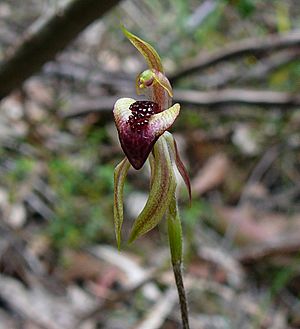Thick-lip spider orchid facts for kids
Quick facts for kids Thick-lip spider orchid |
|
|---|---|
 |
|
| Caladenia tessellata near Mallacoota | |
| Conservation status | |
| Scientific classification | |
| Genus: |
Caladenia
|
| Species: |
tessellata
|
| Synonyms | |
|
|
The thick-lip spider-orchid, also known as Caladenia tessellata, is a special plant. It belongs to the amazing orchid family. This orchid is found only in south-eastern Australia, which means it is endemic there. It grows on the ground and has a single leaf that feels a bit hairy. Its flowers are usually yellowish-green with cool dark red marks.
Contents
What Does This Orchid Look Like?
The thick-lip spider-orchid is a perennial plant, meaning it lives for more than two years. It's a deciduous herb, so its leaves fall off at certain times. This plant grows from an underground part called a tuber.
Leaves and Stems
Each orchid has one leaf that is a bit hairy. This leaf is shaped like a line or a spear. It can be 50 to 100 mm long and 4 to 9 mm wide. The plant also has a thin, strong stem that grows 20 to 150 mm tall.
Flowers and Petals
On this stem, you can find up to three yellowish-green flowers. These flowers have cool dark red marks. The parts of the flower that look like petals are called sepals and petals. They get very thin and pointy at their ends.
- The top sepal stands up at first, then bends forward. It is about 15 to 25 mm long.
- The side sepals curve downwards and are almost parallel to each other. They are also 15 to 25 mm long.
- The petals are similar in size and also curve downwards.
The Labellum
The most interesting part of the flower is the labellum. This is a special lip-like petal. It is cream-coloured or green and often has a dark red tip. The labellum is shaped like a heart and is about 8 to 9 mm long and wide.
Its sides sometimes have small, blunt teeth. The very tip of the labellum curls under. In the middle, there are four to six rows of shiny black bumps called calli. These calli look a bit like a mosaic, which is how the orchid got its scientific name. This orchid usually blooms in September and October.
How Was This Orchid Named?
The thick-lip spider-orchid was first officially described in 1876. A scientist named Robert Fitzgerald wrote about it in his book Australian Orchids. He found a sample of the plant in a place called Hunters Hill.
The second part of its scientific name, tessellata, comes from a Latin word. It means "inlaid with small square stones" or "mosaic". This name was chosen because the labellum, or lip, of the flower looks like it's covered with small, thick bumps, just like a mosaic.
Where Does This Orchid Live?
You can find this special orchid in areas close to the coast. It grows from Swansea in New South Wales all the way down to Westernport Bay in Victoria. There is also one group of these orchids found further inland near Braidwood. It usually likes to grow in woodlands where there is also a lot of grass.
Protecting the Thick-Lip Spider-Orchid
There are only about 19 known groups of Caladenia tessellata left. In total, there are around 450 plants. Six of these groups are in New South Wales, but some haven't been seen for over 20 years.
The biggest group in New South Wales is in the Morton National Park. In Victoria, the largest group lives in the Wilsons Promontory National Park. This orchid is considered "vulnerable" by the Australian Government. This means it needs protection to survive.
Threats to the Orchid
Several things threaten the thick-lip spider-orchid:
- Habitat disturbance: Things like road work can damage where the orchids grow.
- Trampling: Many plants are near walking paths, so people might accidentally step on them.
- Fire: Changes in how often fires happen can harm the plants.
- Animals: Kangaroos and wallabies sometimes eat the orchids.


